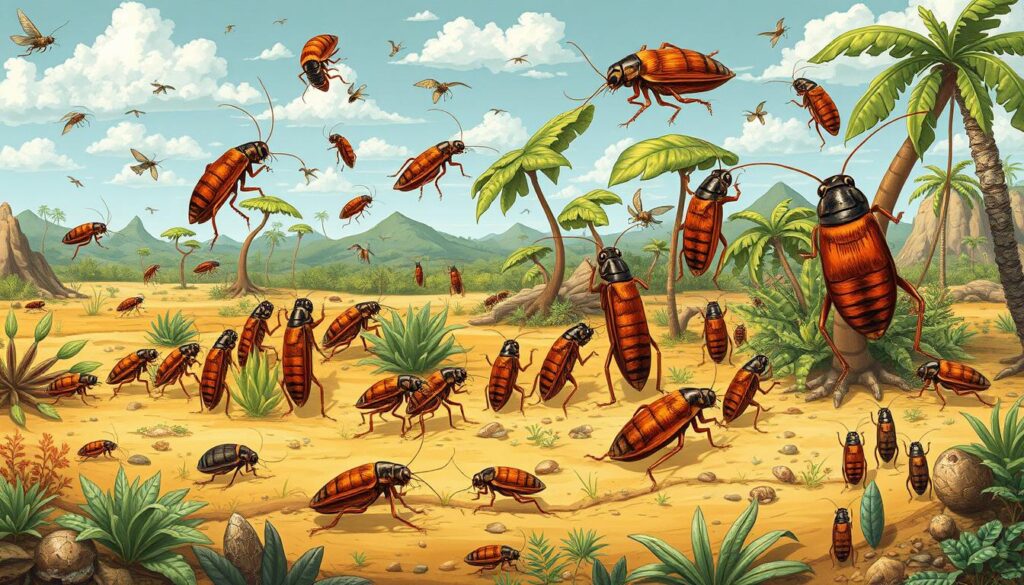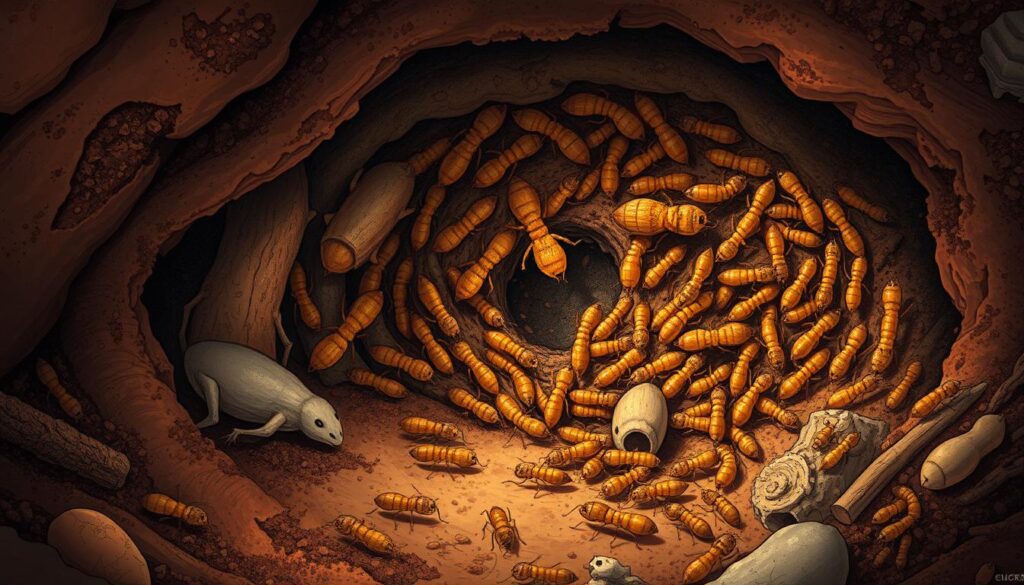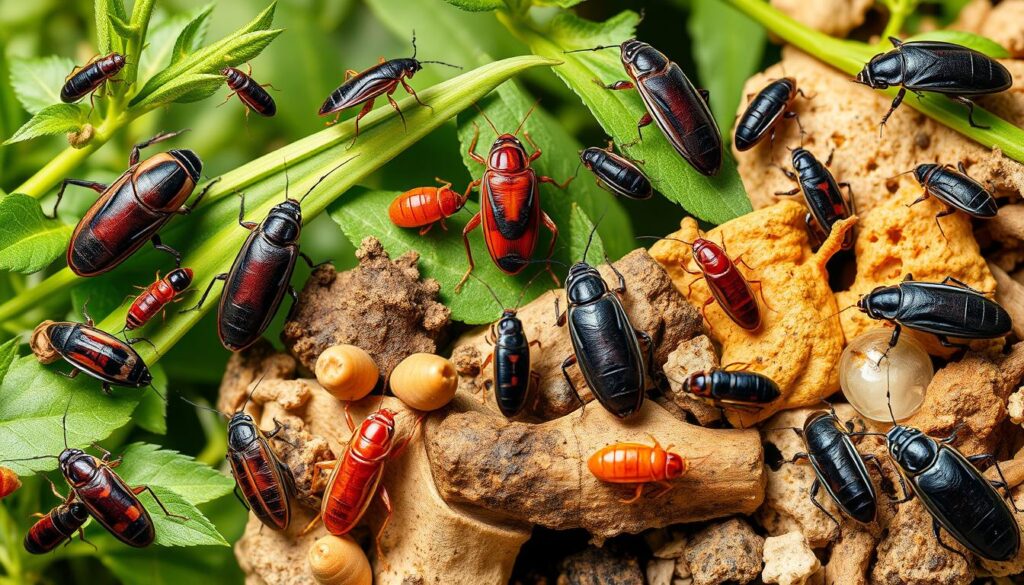Explore the diverse Blattodea families, including cockroaches and termites
The Blattodea order is vast and fascinating, with over 4,000 species of cockroaches and termites worldwide. Knowing about the different blattodea families helps us understand cockroach classification and the variety of roach species.

From tiny, winged cockroaches to large, social termites, the diversity is stunning. Each species has evolved to thrive in different ecosystems. Studying these families and classifications gives us insights into their evolution and behaviour. They play a key role in our environment’s balance.
Introduction to Blattodea
The Blattodea order is complex and intriguing, with a rich history and many species. Exploring the different families and their traits helps us appreciate the importance of cockroach classification. It also highlights the variety of roach species in our world.
Key Takeaways
- The Blattodea order comprises over 4,000 species of cockroaches and termites.
- Understanding blattodea families and cockroach classification is essential to appreciate the importance of these insects.
- The different roach species play a vital role in maintaining the balance of nature.
- The Blattodea order is incredibly diverse, with different species adapted to survive in various ecosystems.
- Studying blattodea families and cockroach classification can provide valuable insights into the evolution and behaviour of these insects.
- The Blattodea order has a rich history and a wide range of species.
Understanding the Blattodea Order
The Blattodea order has over 4,000 species and has stayed mostly the same for millions of years. Fossil records show they’ve been around for over 300 million years. Knowing about the Blattodea order is key for controlling pests like cockroaches.
These insects have flat, oval bodies and can live in many places. Insect taxonomy helps us understand their evolution and diversity. By studying their unique traits, scientists learn about the history of the Blattodea order.
Evolution of Blattodea Species
Blattodea species have evolved to live in different places. This ability to adapt has helped them survive in various environments, from forests to cities.
Also read What Do Cockroaches Eat?
Key Characteristics of the Order
Some important traits of the Blattodea order are:
- Flat, oval-shaped bodies
- Ability to thrive in a wide range of environments
- Unique features such as antennae and wings
Historical Classification Changes
Changes in how we classify the Blattodea order have shaped our knowledge. By looking at these changes, scientists can understand the complex relationships within the order. It helps with pest control and knowing about common cockroach families.
Classification Description
Blattodea Order of insects comprising over 4,000 species
Cockroaches are Common name for insects within the Blattodea order
Insect Taxonomy Study of the classification and evolution of insects
Major Blattodea Families and Their Characteristics
The Blattodea order has several major families, like Blattidae, Blattellidae, and Termitidae. Each family has its special traits. To learn about the types of roaches, we need to look at the cockroach family tree and learn how to identify cockroach species.
Here are some key families and their traits:
- Blattidae: This family includes the largest cockroach species, with some reaching lengths of over 7 cm.
- Blattellidae: This family is commonly found in homes and buildings and includes species like the German cockroach.
- Termitidae: This family includes termites, social insects living in colonies.
Size, colour, and body shape are important when identifying cockroach species. The cockroach family tree is complex. But knowing the different types of roaches helps us understand Blattodea better.
Family Characteristics
Blattidae : Largest cockroach species, some reaching lengths of over 7 cm
Blattellidae, Commonly found in homes and buildings, includes species like the German cockroach
Termitidae Social insects that live in colonies
The Fascinating World of Cockroach Evolution
Cockroaches have been on Earth for over 300 million years. Their fossil records show they’ve changed little over time. This shows their amazing ability to adapt and survive. Learning about cockroach evolution helps us understand the variety of blattodea families and their place in nature.
Ancient Origins
The first roach species appeared during the Carboniferous period. These early cockroaches were small and had no wings. They ate decaying plants. Over millions of years, they evolved into different cockroach classification groups, each with its traits.
Adaptive Features
Cockroaches have special features that help them live in many places. They can go without water, breed fast, and resist radiation. Some blattodea families can even make bad-tasting secretions or make loud hissing sounds.
Modern Species Development
Today, there are over 4,000 known roach species. They range from tiny, ant-like cockroaches to big, flying ones. Each species has its role in nature, helping break down organic matter and being food for other animals. Knowing cockroach classification and blattodea families is key for controlling pests and protecting useful species.
Species Characteristics Habitat
American Cockroach Large, winged, brown Warm, humid environments
German Cockroach Small, light brown, fast-breeding Urban areas, kitchens, bathrooms
Oriental Cockroach Dark brown, shiny, slow-moving Damp, dark areas, such as basements
Termite Families: The Social Cousins
Termites are social insects that live in colonies. They have different castes with unique roles. In insect taxonomy, termites are close to cockroaches. Knowing about termite families helps in pest control identification.

Some common cockroach families are also related to termites. They share similar traits. For example, the Blattidae family includes both cockroaches and termites. Entomologists use morphological characteristics and molecular techniques to identify termite species.
Termite families have a social structure. They have different castes for different tasks. For instance:
- Workers: responsible for foraging and caring for young
- Soldiers: responsible for defending the colony
- Reproductives: responsible for producing new offspring
Knowing these traits is key for effective pest control identification and management.
Termites are often called the “social cousins” of cockroaches. They share a similar social structure and behaviour. By studying termite families, we can better understand these insects. This helps us develop effective strategies for managing them.
Common Household Cockroach Species
There are many types of roaches found in homes. Knowing about the cockroach family tree helps us identify them and prevent infestations. The American, German, and Oriental cockroaches are common in homes.
Each species has its look, like size and colour. For instance, the American cockroach is big, while the German cockroach is small and quick. Knowing which cockroaches you have is key to getting rid of them.
- American cockroach: large size, reddish-brown colour, and a distinctive shape
- German cockroach: small size, light brown colour, and a flattened body
- Oriental cockroach: dark brown colour, glossy body, and a distinctive odour
Knowing about different roaches helps homeowners prevent and get rid of them. Steps include sealing cracks, removing food, and using traps or insecticides. Identifying cockroach species is crucial for a clean, healthy home.
Species Size Color Shape
American Cockroach Large Reddish-brown Distinctive
German Cockroach Small Light brown Flattened
Oriental Cockroach Medium Dark brown Glossy
Ecological Roles and Environmental Impact
Blattodea families are key in the ecosystem. They help break down organic matter and are a food source for other animals. Knowing the cockroach classification helps us understand their roles. For example, some roaches specialize in breaking down organic matter, while others prey on other animals.
The impact of the Blattodea families on the environment is complex. They help recycle nutrients and keep ecosystems balanced. However, some roach species can be pests, damaging crops and buildings and spreading diseases. Understanding the cockroach classification is crucial to manage their negative impacts effectively.
- Decomposition of organic matter
- Food source for other animals
- Nutrient cycling
Understanding blattodea families’ ecological roles and environmental impact is key. By recognizing the importance of roach species in ecosystems, we can balance their benefits and drawbacks. This helps in developing effective conservation and management strategies.
Unique Adaptations Across Different Families
Knowing how different cockroach families adapt is key in the world of insects. Each family has special traits to live well in different places. For example, some can make bad smells or sounds to keep predators away.
How they have babies also varies. Some can make babies without a male, while others have fancy courtship dances. What they eat is another unique thing. Some only eat wood or fabric, while others eat almost anything.
Knowing these special traits helps us fight pests better and protect good bugs. By studying these differences, scientists can find weak spots in pests. This knowledge also helps us save insects and appreciate their diversity.
The table below shows some special ways different cockroach families adapt:
Family Defense Mechanism Reproductive Strategy Feeding Behavior
Blattidae Unpleasant odours Parthenogenesis Generalist feeder
Blaberidae Sound production Complex mating rituals Specialized feeder
Blattellidae Camouflage Multiple mating partners Omnivorous feeder
We can better tackle pest control and conservation by understanding these special traits. It opens up a world of knowledge about insects and how to protect them.
Geographic Distribution of Blattodea Families

The Blattodea family includes many types of roaches found worldwide. Knowing the cockroach family tree helps us identify and understand their distribution. These insects live in various climates and ecosystems, from tropical to temperate regions.
In tropical areas, certain cockroaches do well in warm, humid weather. They have special features like better senses to help them survive and reproduce. On the other hand, temperate regions have roaches that adapt to cooler temperatures and seasonal changes. We need to know these roaches’ physical traits and behaviours to identify them.
Tropical Species
- Enhanced sensory organs
- Specialized reproductive strategies
- Adaptation to high temperatures and humidity
Temperate Region Varieties
- Thickened cuticles for insulation
- Behavioural adaptations for seasonal changes
- Dietary adjustments for limited food sources
Some cockroach species have adapted to living in urban areas. We can see their diversity and resilience by studying where Blattodea families live and identifying cockroach species.
Region Species Characteristics
Tropical American Cockroach Enhanced sensory organs
Temperate German Cockroach Thickened cuticles
Urban Oriental Cockroach Behavioral Adaptations
Conclusion: The Importance of Understanding Blattodea Diversity
Exploring the Blattodea families shows us how vital it is to grasp their diversity. Cockroaches and termites, with their long history and complex societies, teach us a lot. They help us understand the natural world better.
We can fight pests more effectively by learning about cockroach classification and roach species adaptations. This also helps protect important species.
Research and education on Blattodea are key to appreciating these insects more. They are crucial in many ecosystems because of their survival skills and roles. As we learn more about Blattodea, we can work to save endangered species and keep our environment balanced.
Let’s dive into the world of Blattodea, with all its wonders and challenges. By studying these insects, we gain new insights into life. We might even find inspiration in their incredible journey through evolution.
FAQ
What are the major families within the Blattodea order?
The Blattodea order has big families like Blattidae, Blattellidae, and Termitidae. Each family has its special traits and features.
How do I identify common household cockroach species?
Common cockroaches in homes are the American, German, and Oriental cockroaches. You can tell them apart by their looks and how they act.
What are the key characteristics of the Blattodea order?
The Blattodea order is very old, with fossils showing little change. They have special ways to defend themselves, reproduce, and eat. These help them live well in different places.
How do Blattodea families contribute to the ecosystem?
Blattodea families help break down organic matter and feed other animals. But they can also spread diseases and harm crops and buildings.
What is the geographic distribution of Blattodea families?
You can find Blattodea families everywhere, from tropical to urban areas. Each place has its cockroach species that fit the local weather and conditions.
How has the classification of Blattodea species changed over time?
Our understanding of Blattodea species has grown, leading to changes in how we classify them. Some species have been reclassified, and new families have been recognized.

Pingback: Rottweiler diet plan for weight management - rottweilerlover.com
Pingback: Blattodea Food - blattodeaworld